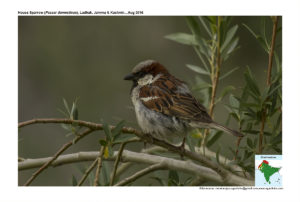House Sparrow

House Sparrow Passer domesticus
Etymology:
- Passer : Latin word for Sparrow
- Domesticus : Latin word for “belonging to the house, domestic” derived from domus –house
Vernacular Names: Baluchistan: Ginjishki, Hindi: Gouriya, Urdu: Gouriya, Kash: Kantur (M), Tsar (F), Pun: Chiri, M.P.: Garhwa, Bhil: Charkalpe(M), Ben: Choticharai, Ass: Ghonchirika, Mani: Sendang, Nepal: Guora, Guj: Chakli, Mar: Chimni, Ori: Gharachatia, Ta: Chittukuruvi, Ur kuruvi, Adaikalakuruvi, Te: Oorapichchuka, Mal: Angnadikuruvi, Kuruvi, Narayanappakshi, Kan: Gubbachi, Gubbi, Sinh: Gekurulla
Distribution in India: Widespread resident in India.
Description: Size 16–18 cm, wt. of 20–39 g .The male of nominate racein breeding plumage has characteristic head pattern, with grey crown, black line from bill to eye, small white postocular spot, chestnut band behind eye and across nape and back of head, pale grey ear-coverts, and white or whitish cheek. The upperparts are brown, streaked black, lower back to uppertail-coverts are brownish-grey; lesser and median upperwing-coverts are chestnut, medians are broadly tipped white, greater coverts are dark brown to blackish-brown with broad chestnut edges and narrow buffish tips; flight-feathers are blackish, secondaries and tertials are edged pale brown, small pale patch at base of primaries. The tail is dark brown to blackish-brown; feathers are with narrow buffish edges. The chin and throat are black, the black extending to variable distance onto breast and sides, pale grey below. Its iris is dark brown; bill is black; legs are brown or dark brown. The non-breeding male differs from breeding in having chestnut colour of nape and most of black bib obscured by greyish feather tips and the bill is horn-coloured. The female is mainly dull brown, with lighter superciliary stripe, upperparts similar in pattern to male’s but duller, lacking chestnut tones; chin and throat are whitish , underparts are paler; bill is brownish with yellower base. The juvenile is like female and young male with hint of greyish bib.
Habitat: It is found in areas primarily associated with man, living around buildings from isolated farms to urban centres, showing preference for suburbs.It is found from lowlands to mountains; up to 4300m.
Food habits: It eats vegetable matter, especially seeds of grasses, cultivated cereals and low herbs, buds, berries and wide range of household scraps, small frogs, small molluscs and crustaceans on shoreline. The nestlings are fed for first three days with animal food, mainly aphids, weevils, grasshoppers and caterpillars, later gradually changing to vegetable diet. The seeds are collected from growing plants and from the ground. It catches arthropods by searching for them.It takes larger insects, such as butterflies, in flight, and dragonflies seized at rest when in semi-torpid state in cool early morning. It is seen in flocks, often large ones outside breeding season.
Breeding habits: They breeds in Feb–Sept, varying with latitude, but can be interrupted by high temperature and monsoon rains. They lay three broods. They breed mainly in loose colonies. The nest-building is started by unmated male, but once pair formed the female takes part, particularly in adding linin to the nest. The nest consists mainly of plant stems, lined with feathers or other soft material. The preferred site for a nest is a hole in building, cliff or tree. They lay a clutch of 2–5 eggs. The incubation is done by both sexes. The incubation period is 11–14 days. The chicks are fed by both sexes. The nestling period is 14–16 days. The fledglings are fed by both parents for up to 2 weeks.